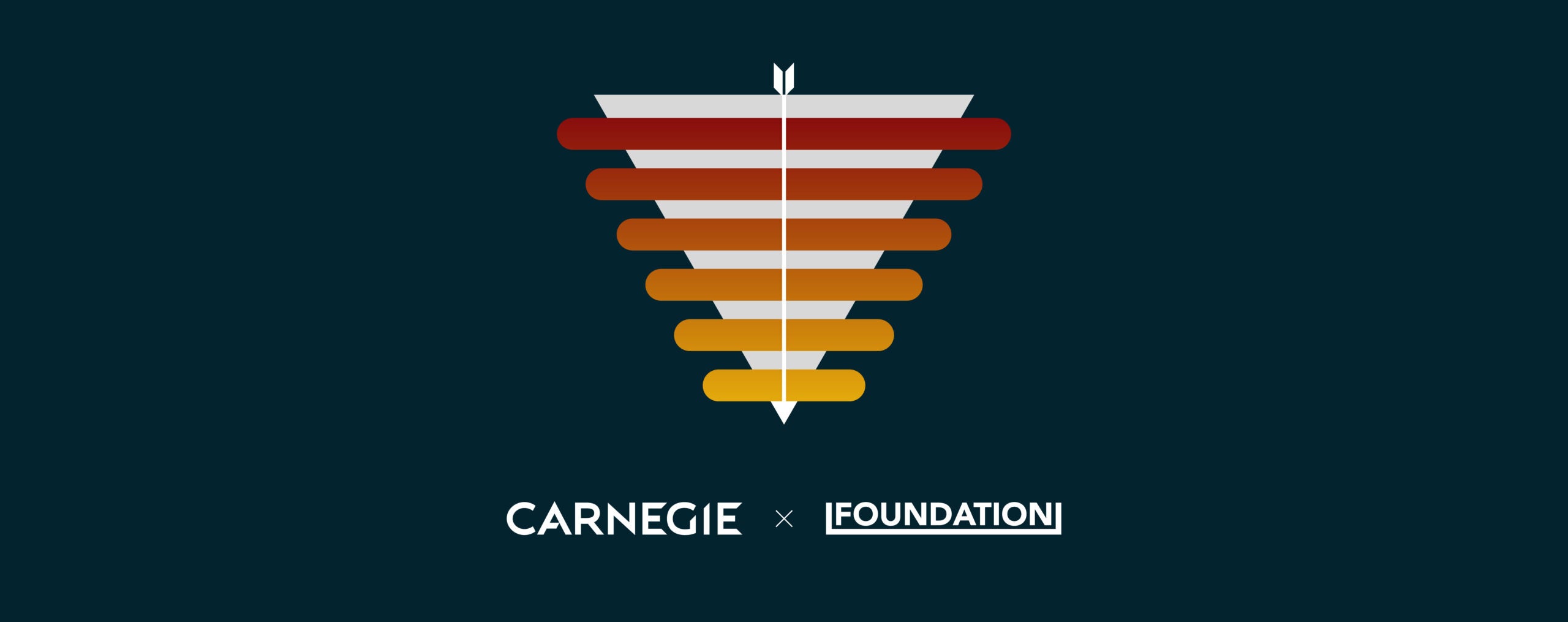 May 15, 2025
Persona
May 15, 2025
Persona
Table of Contents
- Understanding the Enrollment Funnel
- Benefits of A Strong Enrollment Funnel
- Strategies to Guide Students Through the Enrollment Funnel
- Using Data to Drive Success
- Maximizing Enrollment Success with a Full-Funnel Strategy
The higher education landscape is shifting. Shrinking student populations, evolving expectations, and intense competition are forcing institutions to rethink their approach to attracting and enrolling students. The traditional methods of outreach and engagement are no longer enough.
Yet within these challenges lies a major opportunity: the ability to leverage smarter, data-driven strategies to stand out and succeed.
At the core of this transformation is the enrollment funnel—a structured framework that guides prospective students from their first interaction with your institution to the moment they enroll.
But mastering the enrollment funnel isn’t just about generating more leads—it’s about strategically nurturing students at every stage of their journey. That’s where full-funnel marketing comes in.
By aligning marketing and recruitment efforts with each step of the funnel, institutions can create a seamless, personalized experience that drives measurable results.
In this blog, we’ll break down the enrollment funnel, explore the role of full-funnel marketing, and provide actionable strategies to help your institution not only adapt but excel in today’s competitive higher ed landscape. Let’s dive in!
Understanding the Enrollment Funnel
The enrollment funnel consists of six key stages, each requiring a distinct approach to engagement and communication:
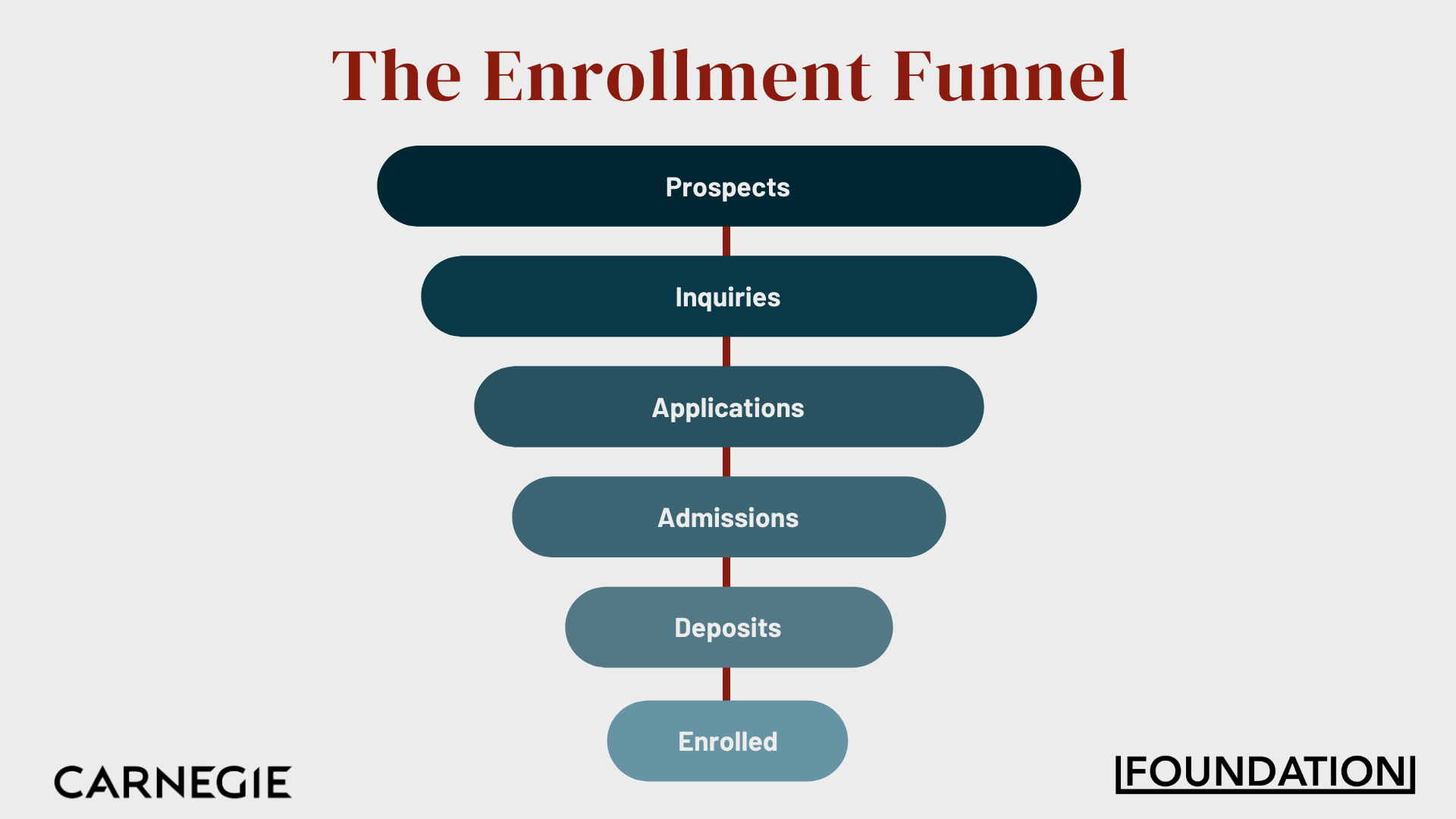
- Prospects – Students who are aware of your institution but haven’t yet expressed interest. At this stage, brand awareness and top-of-funnel marketing efforts are critical.
- Inquiries – Students who take an active step by requesting information, attending an event, or engaging with your website. Here, personalized follow-ups and targeted content can move them closer to applying.
- Applicants – Those who submit an application for admission. Streamlined application processes and strategic touchpoints can reduce friction and increase completion rates.
- Admits – Students who receive an acceptance letter. Strong communication and engagement strategies can help build excitement and prevent drop-offs.
- Deposits – Admitted students who take a major step forward by submitting a deposit. Reinforcement of their decision through community-building efforts can increase yield.
- Enrolls – Students who officially commit and begin their academic journey. A well-executed onboarding experience ensures they feel welcomed and supported.
Each stage presents unique challenges and opportunities. The key to success lies in crafting tailored strategies that nurture students each step of the way, address their concerns, and build lasting trust.
In the next section, we’ll explore how full-funnel marketing helps institutions optimize this process to drive better enrollment outcomes.
Benefits of A Strong Enrollment Funnel
A well-structured enrollment funnel offers numerous advantages, transforming how institutions engage with prospective students. From the initial point of contact to final enrollment, each stage provides opportunities for optimization.
By strategically nurturing students throughout their journey, institutions can see improved outcomes across key performance metrics like conversion rates, resource allocation, and overall student experience.
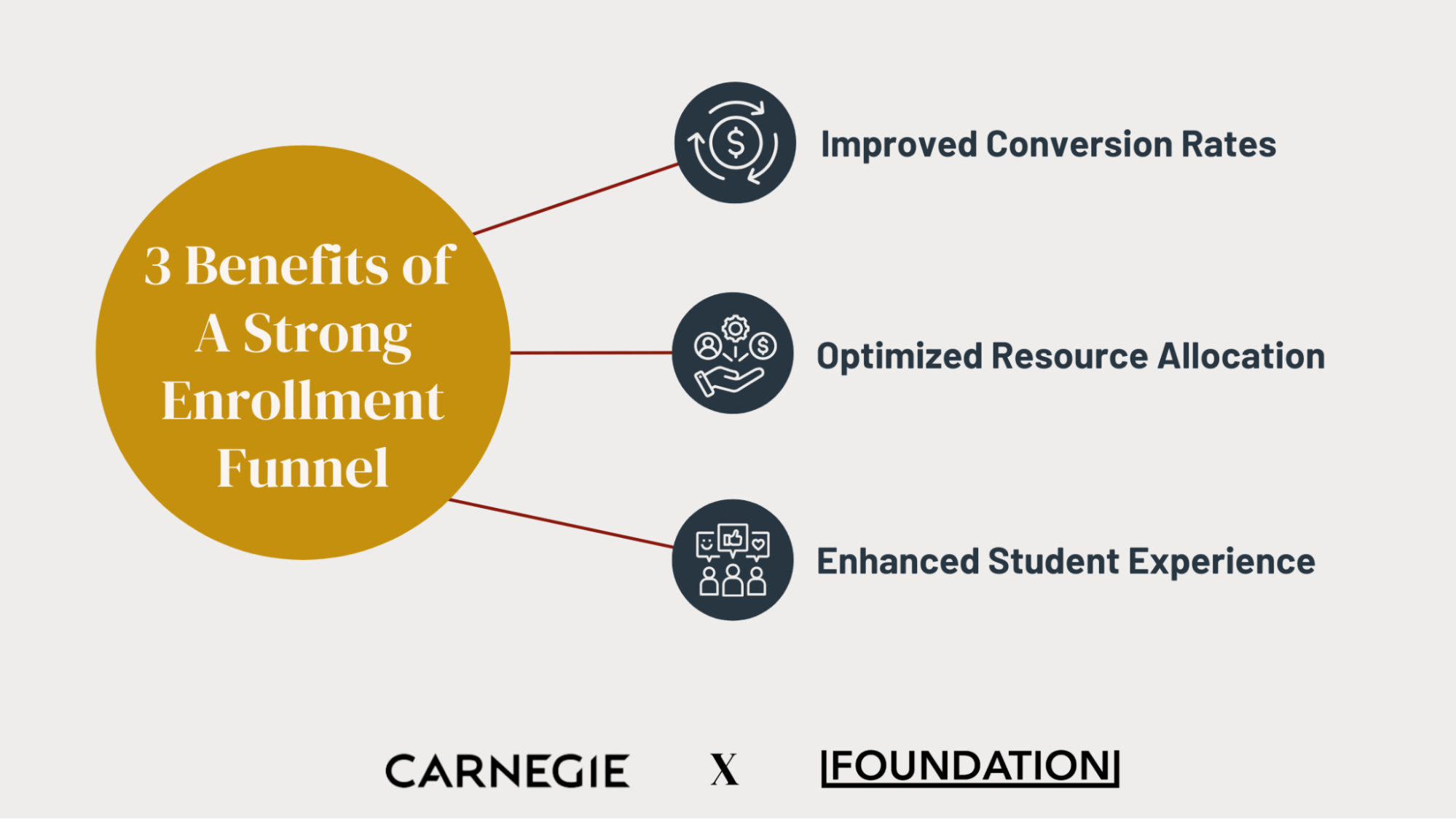
1. Improved Conversion Rates
One of the strongest arguments for adopting a full-funnel marketing strategy is its ability to significantly improve conversion rates at every stage of the enrollment process.
Higher education institutions typically rely heavily on bottom-of-funnel strategies such as application fee waivers, early decision incentives, and deposit deadlines to motivate immediate action. While these strategies are important, they overlook a critical factor: nurturing prospective students long before they reach the application stage.
Data consistently shows that institutions investing in top-of-funnel activities, such as brand awareness campaigns, thought leadership content, and student success stories see higher ROI across the entire funnel. Why? Because these efforts don’t just generate leads; they attract more qualified prospects who have a genuine interest in what the institution offers.
When these students receive consistent, personalized engagement throughout their decision-making journey, they are far more likely to convert into applicants—and ultimately enroll. Consider this example:
A university launches a targeted social media campaign showcasing its unique programs, faculty expertise, and student outcomes. This effort builds brand awareness among high school juniors and seniors exploring their options. As these prospects engage with the content, the university follows up with:
- Personalized email sequences offering program guides, career outcome insights, and student testimonials.
- Virtual events and Q&A sessions where prospects can interact with faculty and current students.
- Retargeting ads reminding students of upcoming application deadlines and financial aid opportunities.
By nurturing prospects from awareness to decision-making, institutions build stronger relationships with prospective students—leading to higher engagement, trust, and ultimately, more applications and enrollments. This proactive, full-funnel approach ensures sustained interest, rather than relying on last-minute recruitment pushes.
2. Optimized Resource Allocation
Another major advantage of full-funnel marketing is its ability to optimize resource allocation by pinpointing exactly where prospective students drop off in the enrollment process. Instead of taking a one-size-fits-all approach, institutions can use data-driven insights to identify “leaks” in the funnel—areas where potential students disengage before reaching the next stage.
For example, are many prospects failing to become inquiries? This could signal weak messaging, ineffective outreach, or a lack of engaging top-of-funnel content.
Are admitted students hesitant to submit deposits? They may need more guidance on financial aid, housing, or what life on campus is really like.
By analyzing enrollment data at each stage, institutions can strategically allocate resources where they will have the biggest impact. Instead of spreading marketing efforts too thin, schools can focus on high-impact interventions that directly address student concerns and improve conversion rates.
Consider this scenario: A university discovers that students from certain regions are less likely to complete their applications due to uncertainty about housing options. Instead of broadly increasing marketing spend, the institution launches targeted digital campaigns featuring:
- Student testimonials about housing experiences.
- Interactive virtual dorm tours.
- Webinars with residential life staff to answer questions in real time.
This precision-based approach not only saves time and money but also ensures that every marketing dollar contributes directly to moving students through the funnel—maximizing both efficiency and enrollment outcomes.
3. Enhanced Student Experience
At its core, full-funnel marketing is not just about optimizing processes. It’s about creating a better experience for prospective students. Today’s students expect personalized interactions and ongoing support throughout their journey. A generic, one-size-fits-all approach is no longer enough.
A full-funnel strategy allows institutions to meet students where they are by delivering tailored content and assistance at each stage of the enrollment process.
- Top of Funnel (Prospects): Use engaging videos and blog posts that showcase campus culture and answer common questions such as, “What makes this institution unique?”
- Middle of Funnel (Inquiries and Applicants): Provide virtual tours, live Q&A sessions with admissions counselors, and program-specific webinars to keep students engaged.
- Bottom of Funnel (Admits and Deposits): Offer one-on-one financial aid consultations or exclusive events for admitted students to build excitement and confidence in their decision.
This personalized approach does more than improve enrollment rates. It strengthens an institution’s reputation and brand perception. Students who feel valued and supported throughout their journey are more likely to recommend the institution to their peers. Many will stay engaged long after graduation, becoming advocates and alumni donors in the future.
The enrollment funnel serves as a structured pathway that guides prospective students from initial awareness to final enrollment. Each stage—Prospects, Inquiries, Applicants, Admits, Deposits, and Enrolls—requires specific strategies designed to nurture students, address their concerns, and inspire action.
Strategies to Guide Students Through the Enrollment Funnel
Higher education institutions can guide students through the enrollment funnel with a strategic approach that nurtures prospects from awareness to decision-making. The following strategies ensure meaningful engagement at every stage, leading to higher enrollment success.
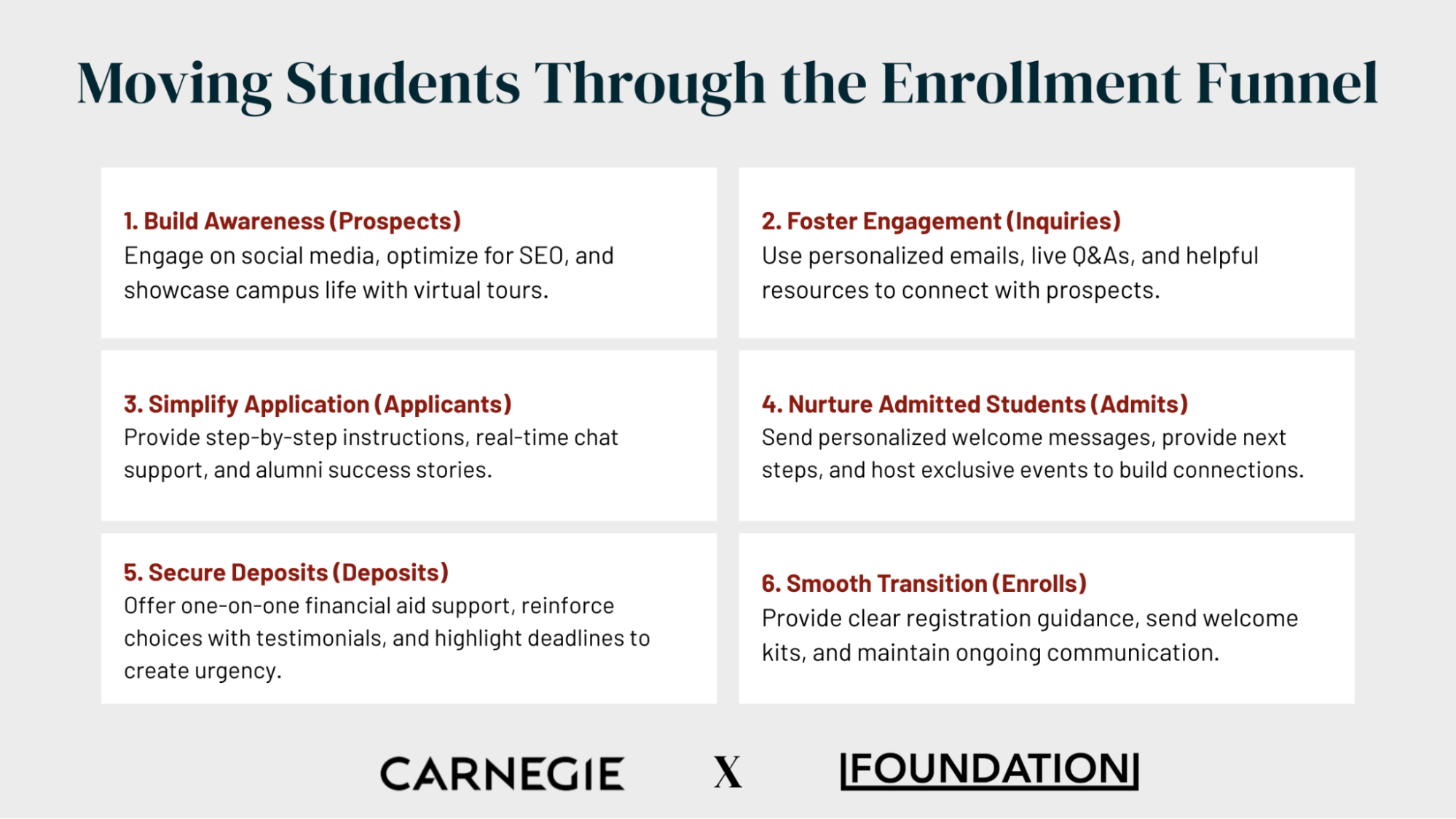
1. Build Awareness at the Top of the Funnel (Prospects)
Attracting prospects starts with building a strong brand presence and creating content that resonates with their needs and aspirations. The goal here is to ensure your institution is on their radar as they begin considering their options.
- Leverage Social Media Campaigns: Tailor campaigns to platforms popular with Gen Z and Gen Alpha (e.g., Instagram, TikTok, YouTube). Highlight campus life, unique programs, and student success stories.
- SEO-Optimized Content: Publish blog posts or articles addressing common questions like “What is college life like?” or “How do I choose the right program?” Ensure your website ranks high in search results for these queries.
- Virtual Tours and Video Content: Showcase your campus culture through immersive virtual tours or engaging videos that highlight academic facilities, extracurricular opportunities, and campus diversity.
By meeting students where they are (online) you can attract a larger pool of prospects who are genuinely interested in what your institution offers.
2. Foster Engagement in the Inquiry Stage (Inquiries)
Once students express interest by making inquiries, it’s crucial to maintain momentum and deepen their engagement. This stage is about building trust and providing the information they need to take the next step.
- Personalized Email Drip Campaigns: Send targeted emails based on their specific interests or inquiries (e.g., program-specific details, financial aid options).
- Live Q&A Sessions: Host virtual events where prospective students can interact with current students, faculty members, or admissions counselors.
- Downloadable Resources: Offer guides like “How to Apply” checklists or program brochures to simplify their decision-making process and provide value upfront.
The more personalized and accessible your communication is at this stage, the more likely students are to move forward in the funnel.
3. Simplify the Application Process (Applicants)
The application process can often feel overwhelming for prospective students. Streamlining this step ensures that more inquiries convert into completed applications.
- Clear Instructions & Deadlines: Provide detailed guidance on how to complete applications and emphasize key deadlines to avoid confusion.
- Chatbots & Live Support: Implement tools that allow applicants to get real-time answers to common questions about forms, fees, or required documents.
- Alumni Success Stories: Share testimonials from alumni who have thrived after attending your institution. This inspires confidence in applicants about the value of choosing your school.
Reducing friction in this stage ensures that fewer prospective students abandon their applications due to unnecessary complexity or confusion.
4. Nurture Admitted Students (Admits)
Acceptance letters are just the beginning—this stage is about reinforcing admitted students’ decisions and building excitement about joining your institution.
- Personalized Congratulations: Send heartfelt acceptance messages via email or even physical mail with branded materials like stickers or welcome cards.
- Next Steps Guidance: Provide clear instructions for critical next steps such as housing applications, financial aid submissions, or orientation registration.
- Exclusive Admitted-Student Events: Host events (virtual or in-person) where admitted students can connect with peers, faculty members, and current students to foster a sense of belonging before they even arrive on campus.
At this stage, it’s all about making admitted students feel valued and excited about their decision to join your community.
5. Secure Deposits (Deposits)
Securing deposits requires addressing any lingering concerns while creating a sense of urgency for commitment.
- Financial Aid Counseling: Offer one-on-one sessions with financial aid advisors to help families navigate costs and payment plans confidently.
- Student Testimonials: Share stories from current students highlighting why they chose your institution and how it has positively impacted their lives.
- Urgency Tactics: Use deposit deadlines or limited spots in popular programs to encourage timely commitments without too much pressure.
This stage bridges the gap between intention and action by alleviating doubts and reinforcing value propositions for hesitant admits.
6. Ensure a Smooth Transition to Enrollment (Enrolls)
The final step is turning deposited admits into enrolled students by making their transition seamless and exciting as they prepare for their first day on campus.
- Clear Registration Instructions: Provide straightforward guidance for course registration, housing assignments, and orientation schedules so students feel prepared upon arrival.
- Welcome Kits: Send branded merchandise like T-shirts or notebooks as a tangible reminder of their new journey ahead—this builds excitement and school pride early on.
- Ongoing Communication: Use onboarding emails or app notifications leading up to orientation day to keep them informed while maintaining engagement during this critical transition period.
A smooth transition not only ensures higher enrollment rates but also sets the tone for a positive student experience from day one.
Using Data to Drive Success
Data-driven strategies are crucial in mastering the enrollment funnel. By leveraging data, institutions can refine their tactics at each stage and optimize their efforts for maximum impact. Here are some key ways institutions can use data to their advantage:
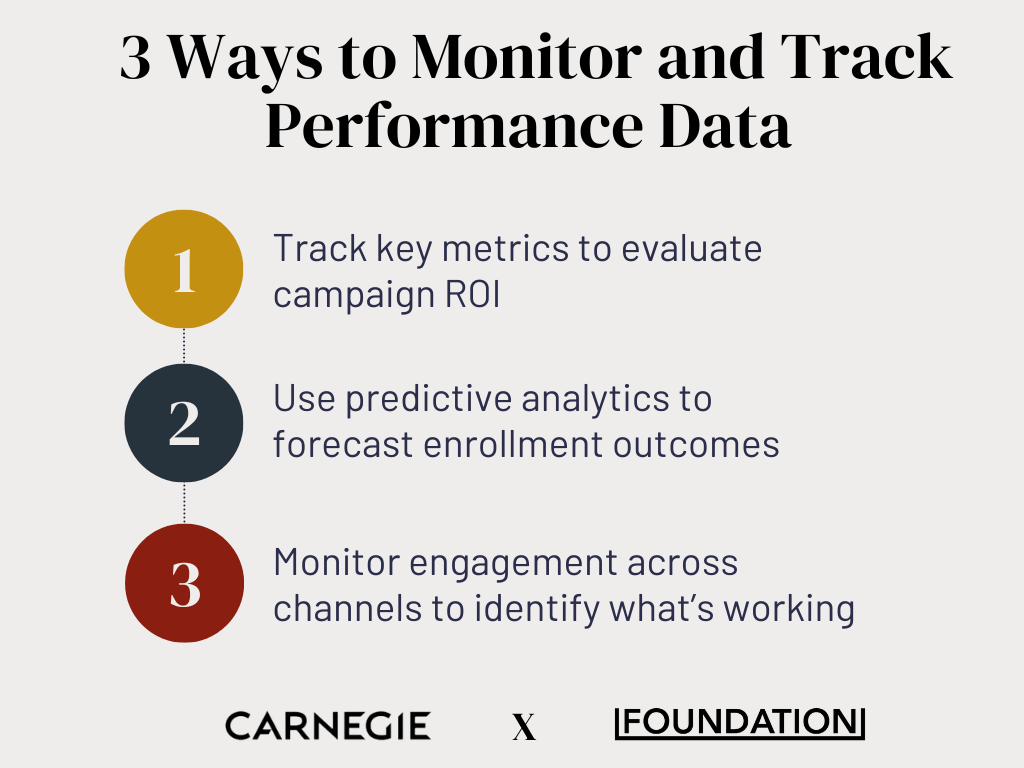
Track Key Performance Metrics
Institutions should monitor critical metrics like Cost Per Inquiry (CPI) and Cost Per Enrolled Student (CPES) to evaluate the efficiency of their marketing campaigns. These metrics help assess the return on investment (ROI) for each tactic and ensure that resources are being spent wisely.
Leverage Predictive Analytics
Predictive analytics allow institutions to forecast the likelihood of student enrollment based on historical data.
By identifying trends in behavior, academic interests, geographic location, and more, institutions can optimize their outreach efforts, ensuring they target the most promising candidates. This data-driven approach not only improves targeting but also helps allocate resources where they will have the most impact.
Monitor Multi-Channel Engagement
Engagement data from various channels, such as email open rates, website traffic, and social media interactions, provides insight into what resonates with prospective students.
By analyzing this data, institutions can adjust their messaging and content to better engage students at each stage of the funnel. Tracking the entire student journey across touchpoints ensures that no lead is lost due to miscommunication or disengagement.
By continuously gathering and analyzing this data, institutions can refine their strategies in real time, ensuring they remain responsive to shifting trends and student needs.
Maximizing Enrollment Success with a Full-Funnel Strategy
The enrollment funnel is far more than just a step-by-step process. It’s an ongoing relationship-building tool. Each interaction with prospective students is an opportunity to demonstrate value, nurture trust, and ultimately drive enrollment.
With a full-funnel marketing approach, higher education institutions can guide students through each stage of the funnel with personalized, data-driven strategies that resonate.
As competition in higher education becomes increasingly fierce and student expectations continue to evolve, adopting a full-funnel approach is not just beneficial—it’s essential.
By prioritizing student engagement, streamlining processes, and utilizing data to continuously optimize efforts, institutions can ensure long-term success and build lasting relationships with students, alumni, and the community at large.
Need help building an enrollment funnel strategy tailored to your institution’s goals?
Reach out to our team of higher education marketing experts.
